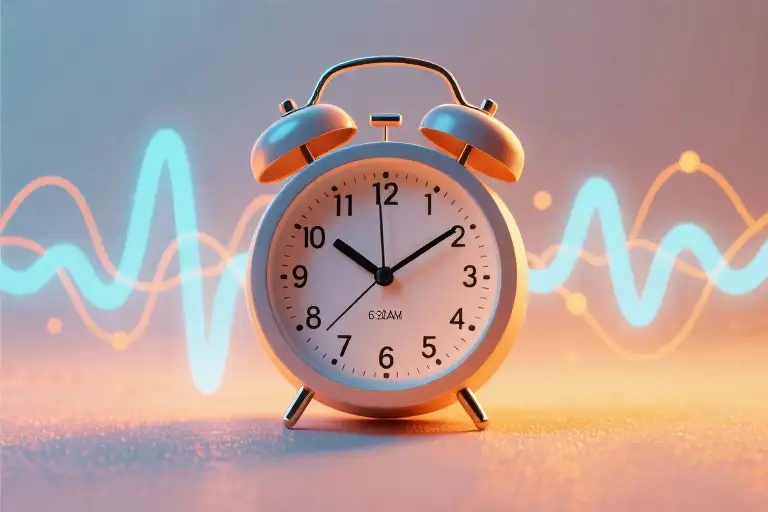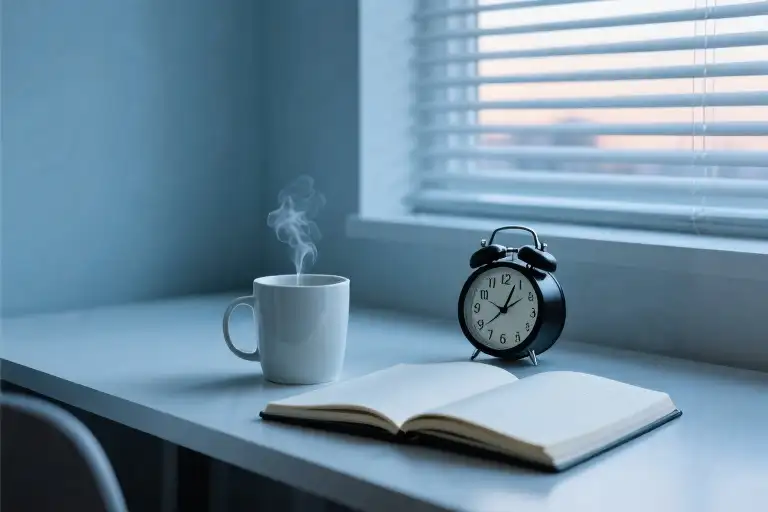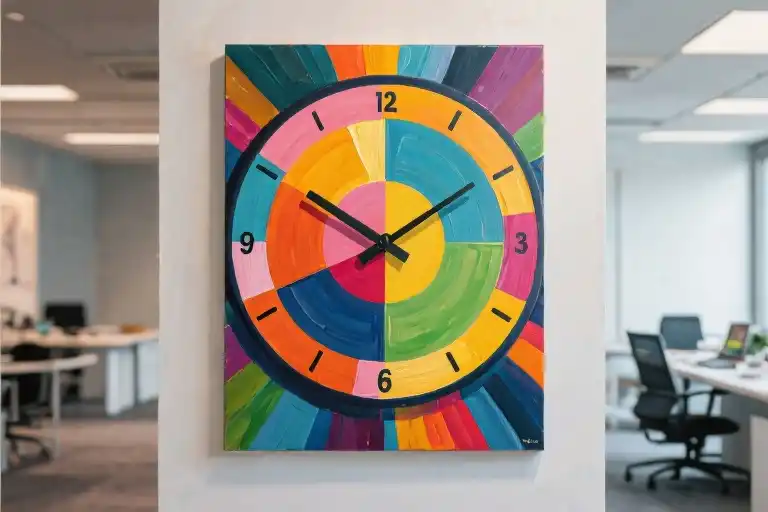The battle between your cozy warm bed and that screaming alarm clock is one we all know too well. That moment when you’re nestled deep in dreamland, wrapped in perfect comfort, only to be violently ripped back to consciousness by a blaring siren or—for some of us—a determined mother shouting from the doorway.
Here’s a startling truth: 83% of people who attempt to become morning persons fail within the first week, according to a 2023 sleep study. The reason? Most of us are fighting our own biology with willpower alone, unaware that our circadian rhythms have been quietly sabotaging every well-intentioned morning routine.
I still remember my college days—staying up until 2 AM watching random YouTube videos, then struggling through 10 AM lectures in a caffeine-fueled haze. Like many, I believed becoming an early riser simply required more discipline. That changed when I discovered the scientific loophole in conventional morning advice during a particularly brutal week of 4 AM wake-up attempts (that lasted exactly one day before spectacular collapse).
What if I told you there’s a way to wake up early without feeling like you’re torturing yourself? This isn’t about grinding through painful routines or chugging endless coffee. The secret lies in understanding three fundamental truths about your body clock that most productivity gurus never mention—truths that explain why you feel worse after “successfully” waking early, why coffee eventually betrays you, and how to actually sync with your natural energy rhythms.
By the end of this guide, you’ll have more than just another motivational pep talk. You’ll hold a science-backed blueprint for transitioning from night owl to morning person—complete with a diagnostic tool to identify your specific stumbling blocks (hint: yours might be the “Ayurveda trap” I fell into), budget-friendly biohacks, and a gradual adjustment method that doesn’t leave you chronically exhausted. The best part? Tomorrow morning’s test run takes just 60 seconds to implement.
Let’s start by examining why all those previous attempts failed—and why that wasn’t your fault.
The Early Rising Diagnosis Room: 5 Types of Morning Struggle Cases
We’ve all been there – the battle between warm blankets and buzzing alarms, the hollow victory of waking early only to crash by noon, the silent shame of snoozing through sunrise promises. Let’s examine five universal patterns of morning struggle through clinical case studies that might feel uncomfortably familiar.
Case 001: The Snooze Addict
Symptoms:
- 7+ alarm snoozes before vertical movement
- Permanent indent on phone’s ‘dismiss’ button
- Morning routines compressed into 11-minute panic
Diagnosis: Disrupted sleep inertia cycle. Each snooze restarts micro-sleep episodes, leaving you groggier than if you’d slept an extra 30 minutes continuously.
Case 002: The Caffeine Zombie
Symptoms:
- Can’t form sentences before third coffee
- 2pm energy crashes requiring emergency espresso
- Mistaking caffeine withdrawal for ‘not a morning person’
Diagnosis: Adenosine receptor overload. Caffeine doesn’t eliminate sleep debt – it just temporarily blocks the fatigue signals, creating a biological lie your body eventually collects on.
Case 003: The Extreme Early Bird (Failed)
Symptoms:
- Proudly waking at 4am…for exactly one day
- 3pm desk naps that could qualify as coma
- Secretly envying ‘lazy’ 7am risers
Diagnosis: Chronotype mismatch. Forcing unnatural wake times disrupts core body temperature rhythms, making sustained early rising biologically unsustainable for 70% of adults (Sleep Medicine Reviews, 2022).
Case 004: The Weekend Overcompensator
Symptoms:
- Weekday alarms: 6am sharp
- Saturday wake-up: 12:37pm (with existential dread)
- Monday mornings feeling like jet lag
Diagnosis: Social jet lag. The 90-minute+ sleep schedule shift confuses your internal clock more than crossing two time zones would (Current Biology, 2017).
Case 005: The Screen Time Saboteur
Symptoms:
- ‘Quick’ 11pm Instagram check → 1:45am Wikipedia rabbit hole
- Morning eyes glued shut despite ‘enough’ sleep hours
- Mysterious inability to recall dreams
Diagnosis: Blue light-induced melatonin suppression. Evening screen exposure can delay sleep onset by 40+ minutes even when you physically get in bed (PNAS, 2019).
Interactive Diagnosis: What’s Your Morning Struggle Type?
Take this quick self-assessment:
- Your ideal Saturday wake-up time is:
a) Same as weekday (5-7am)
b) 1-2 hours later (7-9am)
c) When the sun crosses the yardarm (11am+) - Without caffeine, you feel fully awake by:
a) 8am
b) 10am
c) Does ‘fully awake’ actually exist? - Your bedtime routine usually involves:
a) Reading/meditation
b) Scrolling through feeds
c) Starting new Netflix seasons
Mostly A’s: Natural early riser struggling with maintenance
Mostly B’s: Moderate chronotype fighting modern distractions
Mostly C’s: Night owl being punished by morning norms
The Hidden Trap in Traditional Wisdom
Ancient systems like Ayurveda (with its 4am Brahma muhurta) or Benjamin Franklin’s ‘early to bed’ advice came from:
- Pre-electricity light environments
- Agricultural societies needing daylight labor
- Cultures with afternoon siesta traditions
Modern research shows:
- Only ~15% genetically qualify as true ‘larks’
- Forced early rising can reduce cognitive performance by 30% in evening types (Sleep, 2021)
- Productivity peaks vary by 5+ hours between chronotypes
The real solution isn’t fighting your biology – it’s learning to work with it through strategic adjustments we’ll explore next.
The Circadian Rhythm Handbook: Why Your Body Resists Early Mornings
That groggy 4 AM wake-up call you attempted last week? It wasn’t just willpower failing you. Your body operates on an intricate timekeeping system that laughs at alarm clocks. Let’s decode why your “early bird” ambitions keep crashing against biological reality.
Your Body’s Hidden Thermometer
Every morning at 3:45 AM, something remarkable happens inside you. Your core body temperature begins its gradual climb from the night’s low of 96°F (35.6°C), preparing your brain for wakefulness. This invisible rhythm explains why:
- 6:30 AM feels impossible during winter (delayed temperature rise)
- Post-lunch crashes occur (natural mid-day dip)
- Night owls genuinely struggle before 9 AM (delayed temperature curve)
A 2022 Harvard study found most people experience their “alertness window” 2-3 hours after their temperature minimum. Forcing yourself awake before this window is like revving a cold engine—possible, but damaging long-term.
Caffeine’s Dirty Little Secret
That life-saving morning coffee? It’s fooling your brain in ways that backfire:
- Adenosine Masking: Caffeine blocks sleep-pressure receptors, creating artificial alertness
- Afternoon Payback: When caffeine wears off, accumulated adenosine hits harder
- Cycle Disruption: Even noon coffee delays melatonin release by 40 minutes (Sleep Medicine, 2021)
The bitter truth: every espresso shot taken after 2 PM makes tomorrow’s 6 AM alarm harder. Try this instead:
- Sunlight chaser: 10 minutes of morning light suppresses melatonin 3x faster than coffee
- Hydration hack: Cold water triggers thermogenesis, mimicking the wake-up temperature rise
Chronotype Reality Check
Your ideal wake-up time isn’t a choice—it’s written in your PER3 genes. Take this quick self-assessment:
| If You… | Likely Chronotype | Biological Prime Time |
|---|---|---|
| Feel alert past midnight | Wolf (Evening) | 10 AM – 2 PM |
| Wake before alarms | Lion (Morning) | 5 AM – 9 AM |
| Need midday naps | Bear (Majority) | 8 AM – 12 PM |
| Have irregular energy | Dolphin (Light Sleeper) | Varies widely |
A startling finding from the University of Surrey: only 13% of people are genetically suited for 5 AM wake-ups. The rest of us are fighting biology with alarm clocks.
Practical Rhythm Hacks
For Night Owls Transitioning Earlier:
- Week 1-2: Shift wake-up time by 15 minutes every 3 days
- Light Therapy: Use a 10,000 lux lamp during breakfast (even cloudy days)
- Dinner Timing: Finish eating 3 hours before target bedtime (digestion affects core temp)
For Morning Types Maintaining Energy:
- Post-lunch walk: 15-minute walk when temperature dips (2-4 PM)
- Strategic napping: 10-minute “caffeine naps” (coffee then immediate rest)
- Temperature cycling: Warm shower 90 minutes before bed to trigger cooldown
Your circadian rhythm isn’t an obstacle—it’s a powerful ally waiting to be understood. Tomorrow when your alarm rings, instead of brute-forcing yourself awake, ask: “What’s my body trying to tell me?” The answer might change your entire relationship with mornings.
The Gradual Adjustment Lab
The 15-Minute Increment Method That Actually Works
Most failed early risers make the same critical mistake: they try to leap from midnight bedtimes to 5 AM alarms overnight. Your circadian rhythm isn’t a light switch – it’s more like a dimmer that needs gradual adjustment. Here’s how to do it right:
Step-by-Step Template:
- Baseline Assessment (Week 0)
- Track your natural wake-up time for 3 days (no alarms)
- Calculate average wake time (e.g. 8:15 AM)
- The Golden 15 (Week 1-4)
- Set alarm 15 minutes earlier than baseline
- Maintain this for 7 full days
- Example progression:
- Week 1: 8:00 AM
- Week 2: 7:45 AM
- Week 3: 7:30 AM
- Week 4: 7:15 AM
- Anchor Habits (Ongoing)
- Immediate sunlight exposure (even 2 minutes helps)
- Consistent breakfast timing
- Fixed wind-down routine
Pro Tip: Use a sleep tracker to monitor your sleep efficiency score – you want to see this number rise as your body adapts.
Emergency Reset Protocol for Night Owls
We’ve all been there – a 2 AM Netflix binge or urgent work deadline throws your schedule off. Instead of spiraling into guilt, try this damage control system:
Next-Day Recovery:
- Light Management
- Wear blue-light blocking glasses if up past 11 PM
- Seek morning sunlight within 30 minutes of waking
- Strategic Napping
- 10-minute power nap before 3 PM (set timer!)
- Avoid “sleep debt” naps over 30 minutes
- Caffeine Calculus
- If you must drink coffee, have it before 10 AM
- Alternate with L-theanine supplements to reduce jitters
72-Hour Reset:
- Day 1: Allow yourself to sleep in (max +1 hour from target)
- Day 2: Return to your current step in 15-minute method
- Day 3: Add 10-minute morning walk to reinforce rhythm
Light Therapy on Any Budget
Your circadian rhythm responds profoundly to light – more than alarms or willpower. These practical solutions scale to your resources:
Budget Tier ($10-30)
- Sunlight Simulation
- Open curtains immediately upon waking
- Take morning coffee outside (double benefit!)
- DIY Dawn Simulator
- Plug-in timer + adjustable brightness lamp
- Set to gradually brighten 30 minutes before wake time
Mid-Range ($50-150)
- Portable Light Therapy Glasses
- Re-Timer or Luminette models
- Wear during morning routine
- Smart Bulb System
- Philips Hue with circadian lighting schedule
- Automates evening wind-down lighting
Premium Option ($200+)
- Medical-Grade Light Box
- 10,000 lux models like Carex Day-Light
- 20-minute sessions while checking email
- Sleep-Tracking Light System
- Withings Sleep Analyzer + compatible lights
- Wakes you during optimal sleep phase
Remember: Consistency beats intensity. Using a $10 sunrise alarm clock daily works better than sporadic $300 device usage.
The Progress Paradox
Here’s what surprises most people: during the first 2 weeks of gradual adjustment, you might actually feel more tired. This is normal – your body is learning to access deeper sleep earlier in the night. Track these subtle wins:
- Earlier natural hunger cues
- Reduced “sleep inertia” (morning grogginess)
- Spontaneous eye-rubbing around new bedtime
If you hit a plateau (common around the 6 AM barrier), try “phase jumping” – maintain your current wake time but shift dinner 30 minutes earlier for 3 days, then resume 15-minute increments.
Your turn: Which adjustment variable (light, timing, or temperature) has most impacted your wake-up routine? Share your experiments in the comments – let’s crowdsource the best hacks!
The Toolbox for Early Risers: Tech and Tradition
Waking up early isn’t just about setting an alarm—it’s about understanding your body’s unique rhythms and having the right tools to support them. After years of trial and error (and plenty of failed attempts), I’ve compiled the ultimate toolkit that combines modern technology with time-tested wisdom.
Sleep Tracker Showdown: Finding Your Digital Sleep Coach
The market is flooded with sleep tracking apps, but not all are created equal. Here’s what actually works based on clinical accuracy tests:
Top Performers:
- Sleep Cycle (iOS/Android): Uses sound analysis to detect sleep phases, with 85% accuracy matching polysomnography tests in detecting REM cycles
- Oura Ring: The gold standard for wearable tracking, measuring body temperature and heart rate variability (HRV) with medical-grade precision
- Pillow (Apple Watch): Best for Watch users, accurately detects when you enter deep sleep based on movement and heart rate patterns
Overrated Options:
- Most basic fitness trackers mistake stillness for deep sleep
- Apps claiming to “analyze dreams” have no scientific basis
- Free apps selling your sleep data to advertisers (check permissions carefully)
Pro Tip: Use any tracker consistently for 2 weeks to establish your baseline before making adjustments. The data means nothing without context.
Ancient Wisdom, Modern Science: Ayurveda’s Morning Rituals Reexamined
That failed 4 AM wake-up attempt I mentioned earlier? Turns out I missed the bigger picture. Ayurvedic Dinacharya (daily rhythm) practices have surprising scientific backing when adapted properly:
Oil Pulling:
- Traditional: Swishing sesame oil for oral detox
- Science: Reduces harmful bacteria (Streptococcus mutans) by 20% according to Journal of Ayurveda studies
Tongue Scraping:
- Traditional: Metal scraper to remove “ama” (toxins)
- Science: Proven to reduce volatile sulfur compounds causing morning breath by 75%
Key Adjustment: The rigid 4 AM wake-up only works if you’re asleep by 9 PM—modern research shows it’s the 7-hour window that matters, not the absolute time.
Real People, Real Schedules: The Jetlag Therapist’s Diary
Meet Sarah, a flight attendant who shared her 3-month adaptation journey:
Week 1-2 (Survival Mode):
- Used 10,000 lux light therapy glasses during pre-landing
- Took 0.3mg melatonin exactly 4 hours before target bedtime
- Tracked sleep with Oura Ring to identify “recovery naps”
Week 3-6 (Adjustment Phase):
- Gradually shifted wake-up times by 15 minutes every 3 days
- Created a “fake sunrise” using smart bulbs (Philips Hue)
- Switched to matcha instead of coffee to avoid afternoon crashes
Week 7+ (Maintenance):
- Now maintains energy through 12-hour timezone jumps
- Secret weapon? A 20-minute yoga nidra meditation replaces 2 hours of lost sleep
Sarah’s biggest lesson: “It’s not about forcing morning energy—it’s about eliminating evening resistance.”
Your Action Plan
- Tonight: Download one recommended sleep tracker
- Tomorrow Morning: Try oil pulling with coconut oil (easier for beginners)
- This Week: Identify one circadian disruptor (late meals, blue light, etc.) to eliminate
Remember: Tools are only helpful if they serve your biology. That fancy sleep tracker won’t help if you ignore its data to binge-watch shows past midnight. The secret isn’t in the gadgets or the ancient texts—it’s in aligning them with your body’s honest needs.
Your 7-Day Early Riser Challenge
Now that we’ve uncovered why traditional wake-up methods fail and how to work with your body’s natural rhythms, it’s time for action. This carefully designed 7-day challenge meets you where you are – no drastic changes, no willpower contests, just science-backed micro-steps.
Day 1: The 1-Minute Morning
Before reaching for your phone:
- Sit up straight in bed
- Take 4 deep breaths (inhale 4 sec, hold 4 sec, exhale 6 sec)
- State one intention: “Today I choose to notice when I feel most alert”
Day 2: Light Before Coffee
Within 5 minutes of waking:
- Open curtains/blinds (or step outside if possible)
- Hold off caffeine for 90 minutes (helps reset adenosine sensitivity)
Day 3: The Bedtime Ripple
Tonight:
- Set a recurring alarm for 15 minutes before your usual bedtime
- Use this time to dim lights and write tomorrow’s 3-word priority (e.g., “Email – Walk – Water”)
Day 4: The Snooze Hack
If using snooze:
- Move alarm across the room
- Upon silencing, immediately stand on a cold floor tile for 10 seconds (triggers wake-up reflex)
Day 5: Temperature Tweak
Before bed:
- Lower thermostat by 2-3°F (cooler temps support melatonin release)
- Prepare warm socks (cold feet disrupt sleep)
Day 6: The Rhythm Test
Track naturally waking moments:
- Note time when you wake without alarm (even if you go back to sleep)
- Compare with sleep cycle calculator (link to your resource)
Day 7: The Victory Lap
Choose one:
- 15-minute earlier bedtime tonight OR
- 5-minute earlier wake-up tomorrow
Celebrate with a daylight walk (no sunglasses if safe)
Going Further
For those ready to dive deeper:
- Chronotype Assessment
Take our 90-second quiz to discover your biological prime time (lark, bear, wolf or dolphin sleep types) - Light Therapy Guide
Budget options from $10 (sunlight tracking) to $200 (medical-grade lamps) with comparison chart - Community Stories
Read how Michael (night shift nurse) and Priya (startup founder) adapted these methods at case studies
Your Turn
Which challenge day seems most achievable? Or most intimidating? Share in the comments – your experience helps others navigating this journey. Remember, progress beats perfection every time.
“You don’t have to see the whole staircase, just take the first step.” – Martin Luther King Jr.





